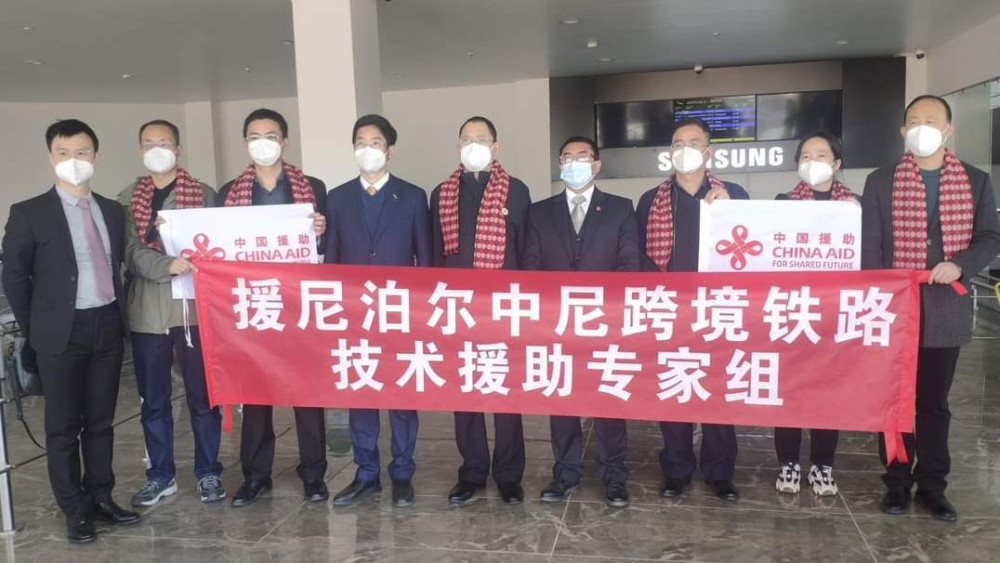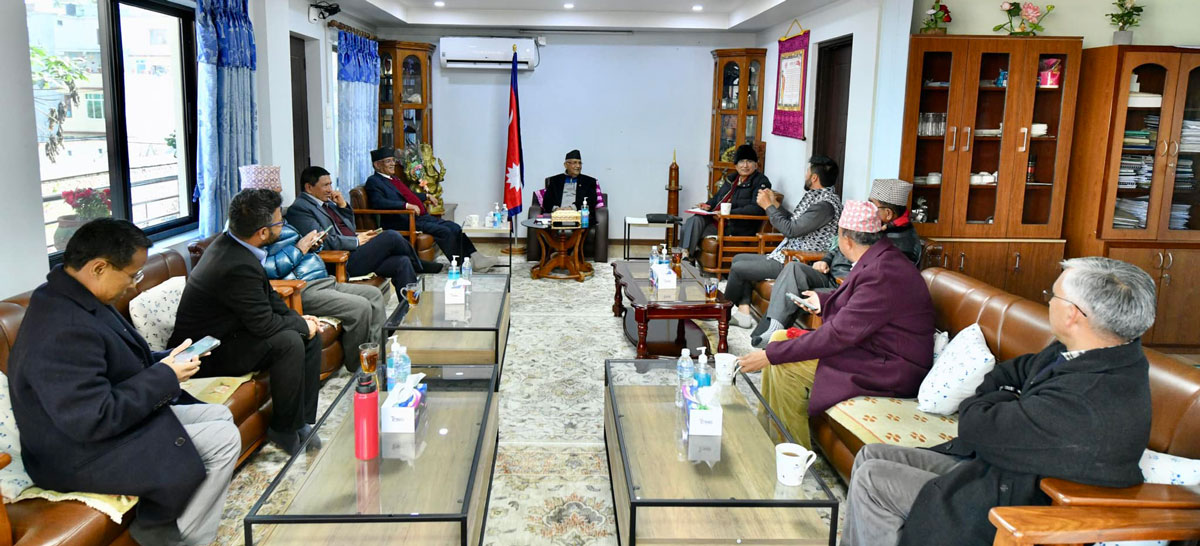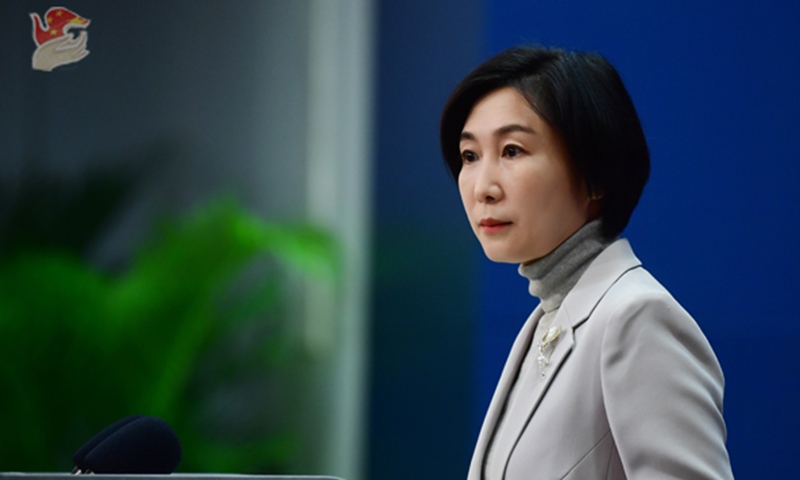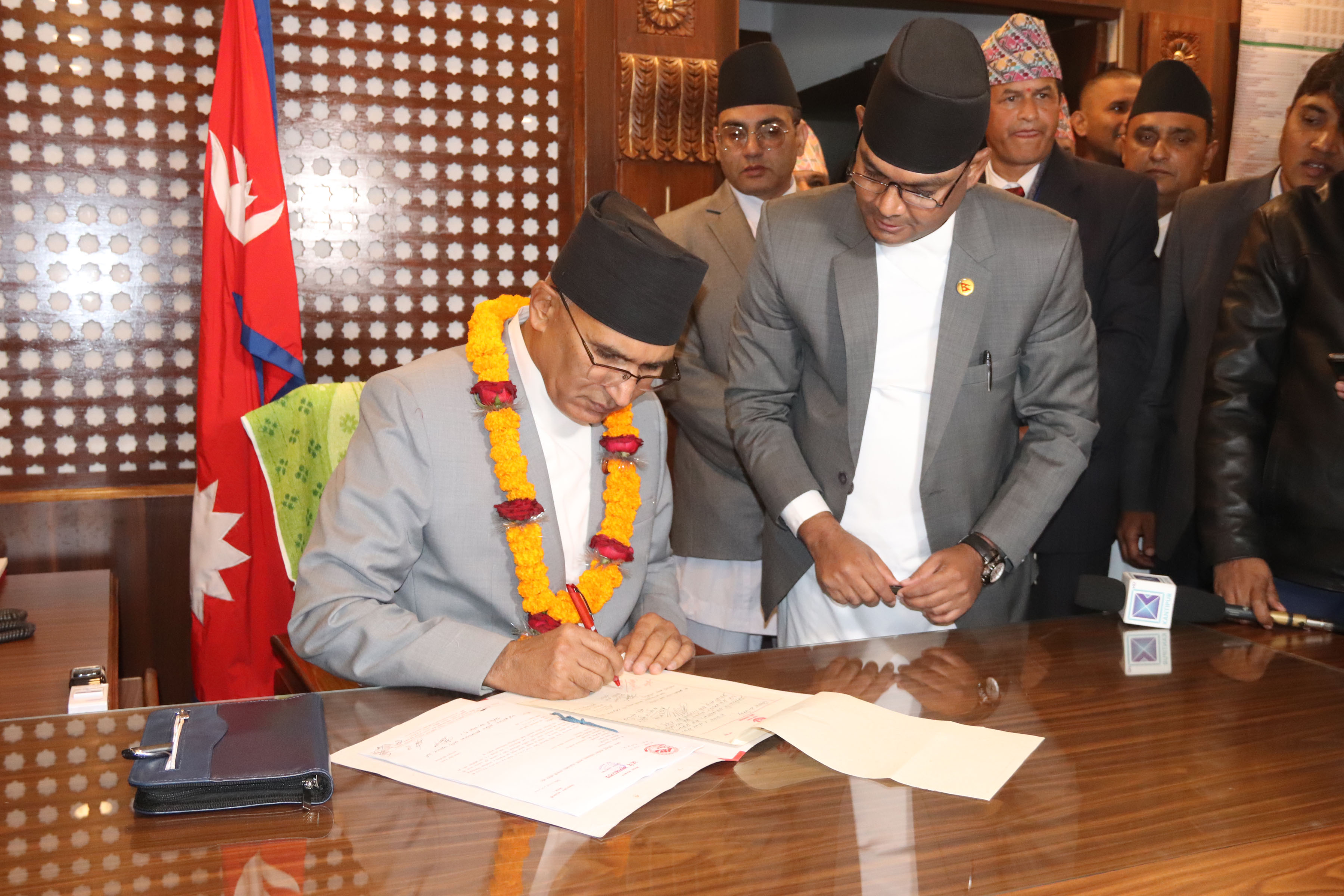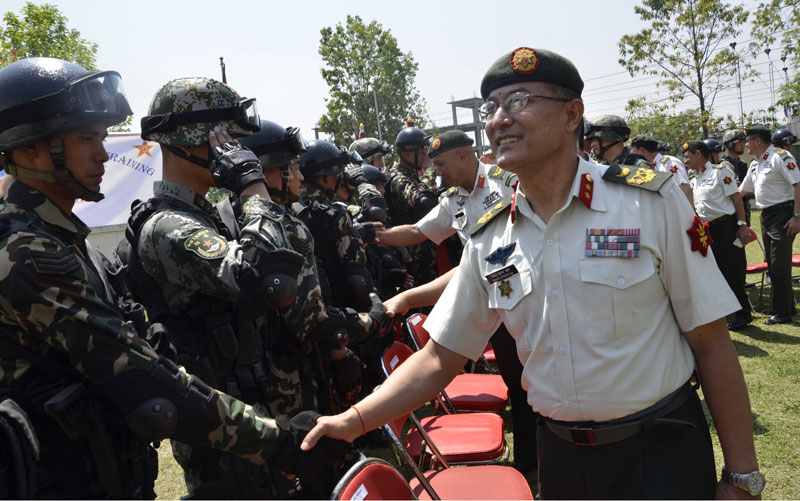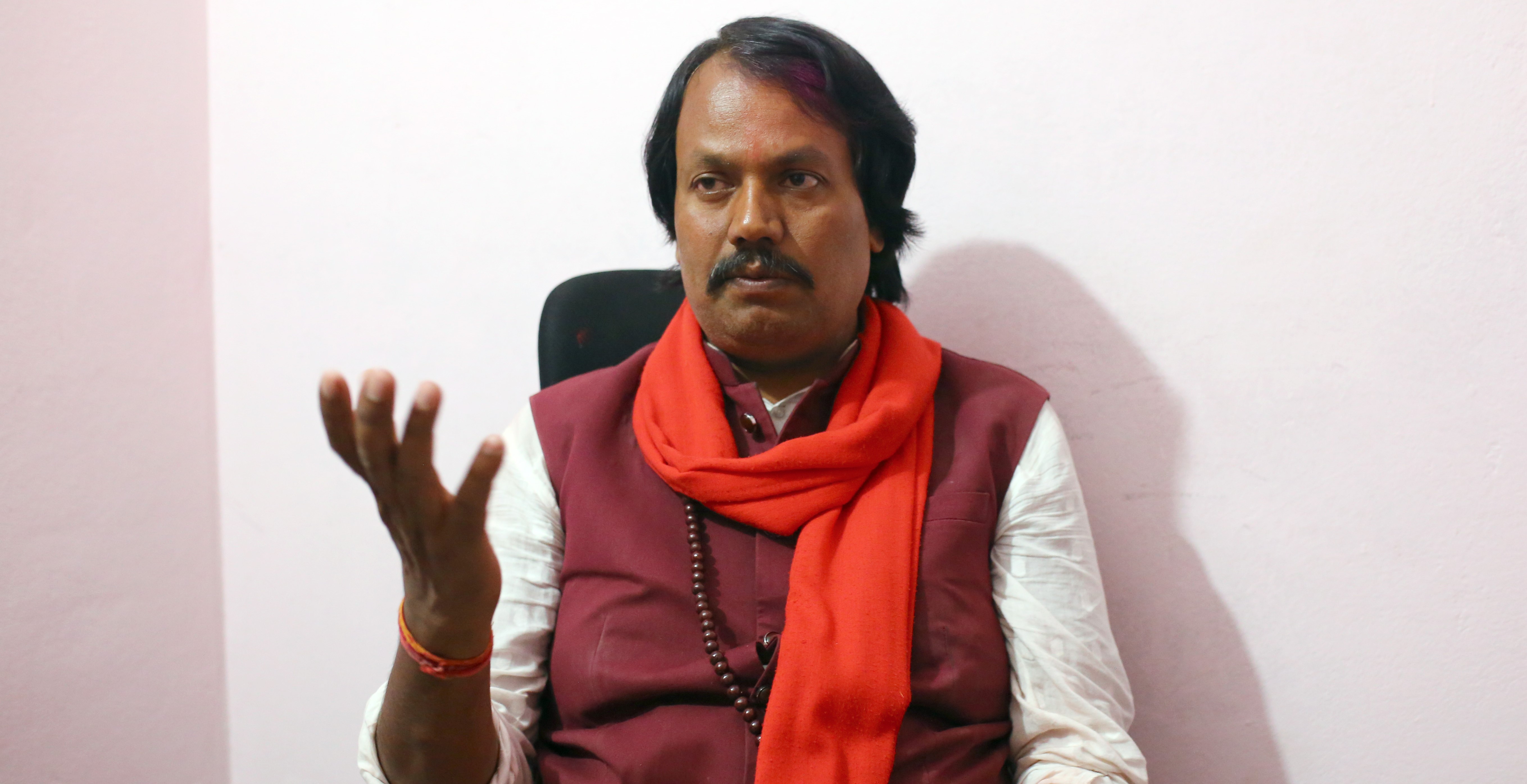Chinese team arrives to study trans-Himalayan railway
A Chinese technical team is in Kathmandu to initiate the feasibility study of the Keyrung-Kathmandu railway line. China has agreed to conduct the study under grant assistance. The team is holding consultations with the Department of Railways, Kathmandu. During the then Foreign Minister Narayan Khakda’s China visit in August this year, China had agreed to conduct the study.
A spokesperson for the Chinese Embassy in Nepal said this arrival is an important step toward the implementation of both countries’ leaders’ consensus, and a solid step to turn Nepal from a land-locked to a land-linked country. The two countries had reached an understanding on this issue during Chinese President Xi Jinping’s Nepal visit in 2019. Pre-feasibility study of the railway, which identified several bottlenecks, has already been completed. The two sides are yet to agree on the investment modality of the railway.
The Chinese delegation landed in Nepal a day after CPN (Maoist Center) Chairperson Pushpa Kamal Dahal assumed office as prime minister. China has also been urging Nepal to give more impetus to its signature Belt and Road Initiative. It may be noted that Kathmandu’s relations with the northern neighbor had thawed during the premiership of Nepali Congress President Sher Bahadur Deuba.
One of the vital trade points with China, the Tatopani customs point, remains literally shut after the 2015 Gorkha earthquake, hampering trade between the two countries. In the past five years since the signing of the BRI framework, negotiations between the two sides have focused on preparing legal documents. The only other achievement in this period was the inclusion of Nepal-China Trans-Himalayan Multi-Dimensional Connectivity Network, including a cross-border railway, in the joint communique of the second BRI conference in 2019.
BRI is basically about taking loans from Chinese banks to build infrastructure. But Nepali leaders who are in conversation with Chinese leaders have been emphasizing grants for the BRI projects. For instance, in 2018, the KP Sharma Oli-led government negotiated with the Chinese on the Keyrung-Kathmandu railway. The Oli government reportedly told the Chinese side to provide a grant for the railway project.
Seven-party alliance likely to sweep provinces too
With the formation of the UML-Maoist alliance, the NC is also likely to lose its strength in all seven provinces as well. The alliance has the required majority to form governments in all provinces. The UML is the largest party in Province 1 and Madhes, while the NC maintains the lead in the remaining five provinces.
In order to form a government in the 93-member Province 1 assembly, parties need the support of 47 members. The UML-led alliance currently has the support of 60 lawmakers, including 40 from UML, 13 from the Maoists, six from the Rastriya Prajatantra Party (RPP), and one from the Janata Samajbadi Party (JSP).
The seven-party alliance is also in a comfortable position in the 53-member assembly of Sudurpaschim assembly. The alliance has the support of 29 members: 11 from Maoists, 10 from UML, seven from Nagarik Unmukti Party (NUP), and one from RPP. In Bagmati province, a new government can be formed without the NC’s support.
In the 110-member assembly, the ruling alliance commands support of 61 members: 27 from UML, 21 from Maoists, and 13 from RPP. The coalition is also in a strong position in the 60-member assembly of Gandaki province, where UML, Maoists, and RPP have a total 32 seats.
The Madhes province assembly has 107 members. So, parties will need the support of 54 members to form a government. The alliance of seven parties currently holds 62 seats in the assembly: 23 from UML, eight from Maoists, 16 from Janata Samajbadi Party, 13 from the Janamat Party, one from the RPP, and one from NUP. Additionally, an independent group of lawmakers led by Prabhu Sah has also joined the alliance.
In the 87-member Lumbini province assembly, the seven-party alliance has 52 members, which is sufficient to form a government. UML and the Maoist Center have 29 and nine members, respectively, while the RRP and NUP have four members each and Janamat has three.
Similarly, the alliance also has a majority in the 40-member Karnali province assembly, with 24 members: 13 from Maoists, 10 from UML, and one from the RPP. This meets the requirement of 21 members to form a new government.
Beijing upbeat as Dahal becomes PM
China has congratulated Prime Minister Pushpa Kamal Dahal expressing willingness to work with the new government to deepen the bilateral ties. “Beijing observed that the election of Nepal was conducted smoothly and we congratulated Dahal for becoming the new prime minister,” Mao Ning, spokesperson for the Chinese Foreign Ministry, told a routine press conference on Monday. “We believe that with the joint effort of the Nepalese government and people, and with the consultation and coordination of various parties and political forces, Nepal will maintain stability and economic and social development.”
Mao further said that China attaches great importance to China-Nepal relations, and is willing to work with the new government of Nepal to expand and deepen friendly exchanges and cooperation between the two countries in various fields. “The two countries will jointly build a high-quality Belt and Road network, injecting new impetus to the development and prosperity of China-Nepal friendship from generation to generation,” she added. Over the last one year, the relationship between the Sher Bahadur Deuba government and China did not go well due to several factors. Beijing felt that the Deuba-led government had tilted toward the West.
Chinese officials openly said that the engagement between two countries slowed down after the formation of the Deuba government. In this period, China expressed its concerns through Dahal, who was a vital coalition partner of Deuba. Beijing also maintained a close communication with Dahal about its interests in Nepal.
“It [Beijing] was always pushing for a left unity in Nepal so Dahal’s appointment as new PM is obviously a good message for us,” said a Beijing-based analyst. The main concerns of Beijing are implementation of past agreements reached between two countries, implementation of Belt and Road Initiative and preserving its core security interests.
Heaps of economic challenges await new finance minister
With the formation of the new cabinet of ministers, all eyes are now on how the Pushpa Kamal Dahal-led government will resurrect the economy and boost the morale of the private sector. As soon as he takes office, the new Finance Minister Bishnu Poudel has to get into action.
As the economy grapples with multiple issues, Poudel has his task cut out. From increasing capital expenditure, improving revenue collection, and uplifting the morale of the private sector, Poudel, in his third stint as Finance Minister, has a lot to do to resurrect the recession-mired economy. The continued recovery of the country’s external sector is expected to give some breathing space to the new finance minister.
The latest macroeconomic report published by the Nepal Rastra Bank (NRB) shows the balance of payment (BOP), remittance inflow and forex reserves all have increased, offering some level of respite to the government. Nepal’s balance of payments (BOP) is at a surplus of Rs 20.03bn, and forex reserves have increased by 2.5 percent to Rs 1,246.27bn in mid-Nov 2022.
The current state of the forex reserve is sufficient to cover merchandise imports for 9.7 months, and merchandise and services imports for 8.4 months. But, declining imports and the slowdown in economic activities have put the government’s budgetary position, primarily in revenue collection, in a shaky position. The government revenue has been declining drastically over the last couple of months.
While the import restrictions on vehicles, expensive mobile sets, and foreign liquors, helped the country to avert the looming forex reserves crisis, the government is now facing another crisis as it struggles to collect the targeted revenue as current revenue collection is not sufficient even to meet growing recurrent expenditure. The government has failed to meet the revenue collection target in the first five months.
According to the Financial Comptroller General Office (FCGO), the government’s revenue collection has a shortfall of Rs 138bn of the target during this period. Poudel, who is known as a ‘facilitator’ for his successful involvement in many political and governmental dealings and a private sector-friendly leader, Poudel will have to first bring the relationship between the Ministry of Finance (MoF) and Nepal Rastra Bank (NRB) to a ‘working level’.
The deterioration of the relationship between the ministry and the central bank during Janardan Sharma’s tenure has cost the economy dearly. Many observers and business community members say the lack of trust between two key institutions driving the economy is the main cause of the current economic mess.
Given that current NRB Governor Maha Prasad Adhikari was appointed by the then UML-led government, it is expected that the finance minister-governor relations will be better during Poudel’s tenure. Economists and private sector representatives say economic revival should be the prime agenda of the new government.
Economist Keshav Acharya says the first thing the new Finance Minister has to do is to convene a meeting with the National Planning Commission and Nepal Rastra Bank to take stock of the economy, i.e., the government fiscal situation, and monetary situation. “As soon as he takes charge of the Finance Ministry, the new minister has to sit down with them (NPC and NRB) for a detailed and serious review of the state of the economy,” he said.
The interest rate of banks and financial institutions has doubled within a year due to a prolonged liquidity crunch. Despite raising the interest rates, banks are struggling to provide loans. On the other hand, the private sector is now reluctant to expand investments by borrowing money at higher interest rates. Poudel has to walk a tightrope of providing stability to the interest rate, as well as boosting the confidence of investors.
Amid the current private sector-government face-off, the most worrying aspect is the deep slowdown in business and production activities. Most types of business activities have slumped to levels never seen before. How the new government and new finance minister re energize the private sector will be the key to the country’s economic revival.
The recent surveys carried out by the Federation of Nepalese Chambers of Commerce and Industry and Confederation of Nepalese Industry show that the capacity utilization of manufacturing industries has hit a new low, investment plans have been put on hold and overall market demand in the country has shrunk dramatically.
The FNCCI survey shows industries producing construction materials like cement and iron, and steel are operating at 30 percent of their installed capacity. The sales of daily consumable goods have declined by 18 percent, while the electrical equipment transactions have decreased by 55 percent. The housing and real estate transactions dropped by 48 percent in the first four months of the current fiscal year, while the stock market transactions have declined by 40 percent during the review period, according to the federation.
Similarly, the CNI survey said that new investments have halted in almost all sectors with 70 percent of investors postponing their new investment plans due to rising interest rates, impact on cash flow, and a huge drop in market demand for goods and services.
With the private sector continuing its protest against high-interest rates and working capital loan guidelines, the new Finance Minister, according to Acharya, should ask the NRB which are the issues that can be addressed and cannot be addressed.
According to Acharya, the new finance minister should also intervene in the country’s development administration to make capital expenditure meaningful. “He should also hold a discussion with the NPC team on what are the issues that hold the government agencies to expedite the capital expenditure,” said Acharya adding that there is an urgent need to identify the legal, administrative and political factors that have been affecting capital expenditure.
The new Finance Minister also has to sit down with the concerned ministries directly related to the economy such as Energy, Industry and Commerce, Physical Infrastructure, and Transport—to expedite capital expenditure as well as resolve the issues related to the private sector. Given the continuous slide in revenue collection, Poudel has the challenge to arrest this slide and improve the revenue. Acharya says Poudel would do well if he implements the report of the Public Expenditure Review Commission.
“Given the state of revenue collection, the Finance Ministry must hold a serious review meeting to find the causes and way out,” said Acharya. The private sector says the first and only priority of the government should be the economy. “Economic revival should be the only priority of the new government,” said Deepak Raj Joshi, Director General of CNI.
I will consider suggestions of experts and stakeholders: Minister Poudel
The newly appointed Deputy Prime Minister and Finance Minister Bishnu Paudel on Monday said that the economy has reached the point of crisis. Paudel said he will work hard to bring the economy back on track. “The economy is on the brink of crisis, we have to work hard to bring it back to a safe place,” Paudel said after assuming office on Monday. “I will identify the problems and consider suggestions of experts and stakeholders to find a solution.”
Dahal’s third innings
President Bidya Devi Bhandari has appointed CPN (Maoist Center) Chairman Pushpa Kamal Dahal the prime minister as per Article 76 (2) of the Constitution of Nepal. The article states: In cases where no party has a clear majority in the House of Representatives pursuant to clause (1), the President shall appoint as the Prime Minister a member of the House of Representatives who is able to command a majority with the support of two or more parties representing the House of Representatives.
With the latest appointment, Dahal has become prime minister for the third time backed by a strength of 169 lawmakers from the UML, Rastriya Swatantra Party and Janamat Party. President Bhandari will administer to him the oath of office and secrecy at 4 pm on Monday.
Dahal became prime minister in 2008 after his party emerged as the largest party. However, he was forced to step down after then President Ram Baran Yadav overturned his decision of sacking Army Chief Rukmangud Katawal.
Second time, he became the prime minister of the government in 2016, backed by Nepali Congress. After the merger of UML and his party in 2018 and formation of a powerful government in 2018, Dahal had expected that Oli would hand over the government leadership after 2.5 years.
Over the past few years, Dahal has been consistently saying that as he hid some mistakes in his first and second tenures, he wants to lead the government to implement his roadmap of peace and development. This time, he had expected that Nepali Congress would support him to form a government but that did not happen. Along with UML, Rastriya Swatantra Party, Rastriya Prajatantra Party, Nagarik Unmukti Party and Janamat Party and Janata Samajbadi Party have supported Dahal.
Is BF.7 a new covid threat?
As of Thursday, there were just 15 active Covid-19 cases in Nepal. But three cases of the Omicron subvariant BF.7—a newly discovered variant—have been found in China and India. The Omicron variant BA.5, of which BF.7 is a sub-lineage, has the strongest ability to cause infection since it’s highly contagious, incubates quickly, and has the ability to infect even those who have received vaccinations.
International media reports that the extremely contagious Omicron strain, primarily BF.7, which is the major variant circulating in Beijing, is currently affecting other cities of China as well. The US, the UK, as well as European countries including Belgium, Germany, France, and Denmark have already reported the new variant. The BF.7, which is believed to be the reason behind the rise of Covid cases in China, is a mutation of the BA.4/5.
Except for China, practically everywhere else it evolved, the new variant has remained steady. No variant, apart from the Delta variant, has been found to have a high mortality rate, despite the fact that several variants have some capacity to resist immunity acquired from previous infections or vaccinations. A recent study indicated that BF.7 could infect even those who have received a third booster dose of the vaccine.
With the exception of China, no scientific investigation has found that it has raised hospitalization rates or overstretched the healthcare system. Dr Sher Bahadur Pun of Sukraraj Tropical and Infectious Disease Hospital, Teku, Kathmandu says Nepal needs to keep a close watch on how things progress in India. “There is no need to panic but we must remain vigilant,” he says.
A press release by the Ministry of Health and Population said though the BF.7 variant hasn’t been seen in Nepal, many other variants have been found in samples collected from different places of the country in the past month. The ministry has urged the public to wear masks, maintain social distance, and wash hands properly.
Nepal, China to resume military drill
Nepal Army is making preparations to hold a military drill with the People's Liberation Army of China after a gap of two years. With China easing the covid restrictions, the two armies are finally set to hold the joint exercise, which they had been holding regularly since 2017.
According to NA spokesperson Narayan Silwal, the army has started the necessary homework for the joint drill.
“The date has not been decided yet, but we are eagerly waiting to start the joint exercise, which was stalled after 2020 due to China’s zero-covid policy. ” India and the US have already resumed joint military exercise with Nepal. In fact, a two-week long joint military exercise between the NA and the Indian Army is currently underway in Rupandehi.
Nepal and India have been holding military drills for the past 13 years. The military drill between the NA and US Army resumed from last year, and they have already held two joint exercises. While China maintains that its covid policy was the reason why the PLA did not conduct any military drills with the NA, security analyst Binoj Basnyat says the pandemic might not be the only reason.
“This is part of Beijing’s strategy. In the last two years, China may have been analyzing how things work with Indian, American and Nepali militaries.” Nepal is important for China in regards to its security strategy. “China was not going to pause the joint military drill with Nepal for long, since India and the US had already resumed theirs.”
CK Raut: We’ll side with the party that takes ownership of our demands
Janamat Party led by CK Raut became a national party after winning six seats in the federal parliament in the Nov 20 election. Raut, who forayed into politics as a radical outsider with his free-Madhes campaign, has tempered his hardline opinion over the years. Now his party has joined mainstream politics and is in the position where it could join the would-be coalition government. Pratik Ghimire of ApEx talks to Raut regarding his political journey and his party.
You boycotted the 2017 polls and now you are leading a national party in the federal parliament. How has the experience been so far?
We should accept natural changes. At some point, the Nepali Congress also boycotted the elections. The Maoists said that they do not accept the parliamentary system, and now they are in the parliament. This happens in politics. It was exciting to participate in the election for the first time. I am excited about how this opportunity will be, and how much success we will achieve. But I have always kept in mind that if we fail, the people will not trust us anymore, and we have to accept that. We have no excuse to be like other ordinary parties.
You started off as a free-Madhes campaigner, only to join mainstream politics to the surprise of many. Can we expect other surprises from you and your party?
People may be surprised because they think traditionally. I make important and quick decisions. I can go against what is going on in society and prevail for the better. I don't have big agendas and ambitions at least. I don’t even want to promise anything big. The reason we established this party is to advocate for common people and provide them employment. This country can be made better by creating job opportunities and controlling corruption. For these, I have made all the decisions. These are not surprises, but the need of the hour.
Is this the right time for your party to get involved in government or strengthen the party organization?
We are now a national party and with six MPs in the federal parliament, we are a decent political force. It is necessary to involve and engage the government to meet our demands. We will work to build the internal system of the party, and I'm sure that involvement in the government won’t hamper our party system.
The past governments have failed to honor the agreements reached in favor of Madhes. The people of Madhes don’t seem to be in favor of Madhes-based parties joining the government either. Do you think the government will address the demands of Madhes the agreements this time?
The governments so far have not been sincere in implementing the agreements. The agreements made by the previous governments with other parties have not been implemented. So, we have been in regular talks with all the parties. We will take the side of the party that is willing to take ownership of our agendas. And I don’t think Madhesi people don’t want us to be in the government. The downfall of other Madhes-based parties was caused due to the path they took for power and personal benefits. Janamat Party is different and it has a clean background.
How does Janamat Party distinguish itself from other Madhes-based parties?
Janamat Party is not a party that broke off from another party to gain power or opportunity. We have built this party from scratch. Janamat Party is run by the people who do not wish to earn a position of power or money. They joined politics to improve the standard of living of the people. It is a party of people who come from a struggling background.


